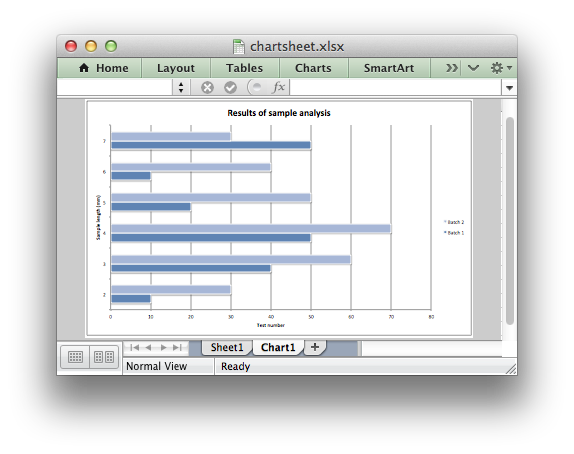Example: Chartsheet#
Example of creating an Excel Bar chart on a chartsheet.

#######################################################################
#
# An example of creating an Excel chart in a chartsheet with Python
# and XlsxWriter.
#
# SPDX-License-Identifier: BSD-2-Clause
# Copyright 2013-2024, John McNamara, jmcnamara@cpan.org
#
import xlsxwriter
workbook = xlsxwriter.Workbook("chartsheet.xlsx")
# Add a worksheet to hold the data.
worksheet = workbook.add_worksheet()
# Add a chartsheet. A worksheet that only holds a chart.
chartsheet = workbook.add_chartsheet()
# Add a format for the headings.
bold = workbook.add_format({"bold": 1})
# Add the worksheet data that the charts will refer to.
headings = ["Number", "Batch 1", "Batch 2"]
data = [
[2, 3, 4, 5, 6, 7],
[10, 40, 50, 20, 10, 50],
[30, 60, 70, 50, 40, 30],
]
worksheet.write_row("A1", headings, bold)
worksheet.write_column("A2", data[0])
worksheet.write_column("B2", data[1])
worksheet.write_column("C2", data[2])
# Create a new bar chart.
chart1 = workbook.add_chart({"type": "bar"})
# Configure the first series.
chart1.add_series(
{
"name": "=Sheet1!$B$1",
"categories": "=Sheet1!$A$2:$A$7",
"values": "=Sheet1!$B$2:$B$7",
}
)
# Configure a second series. Note use of alternative syntax to define ranges.
chart1.add_series(
{
"name": ["Sheet1", 0, 2],
"categories": ["Sheet1", 1, 0, 6, 0],
"values": ["Sheet1", 1, 2, 6, 2],
}
)
# Add a chart title and some axis labels.
chart1.set_title({"name": "Results of sample analysis"})
chart1.set_x_axis({"name": "Test number"})
chart1.set_y_axis({"name": "Sample length (mm)"})
# Set an Excel chart style.
chart1.set_style(11)
# Add the chart to the chartsheet.
chartsheet.set_chart(chart1)
# Display the chartsheet as the active sheet when the workbook is opened.
chartsheet.activate()
workbook.close()